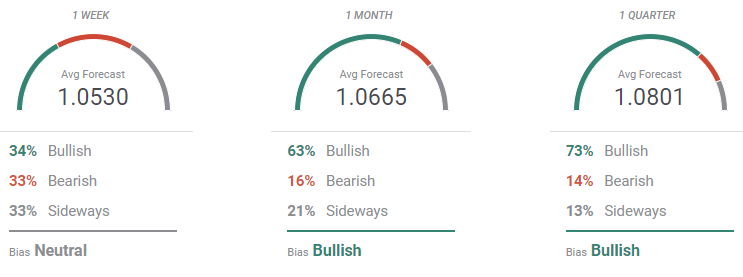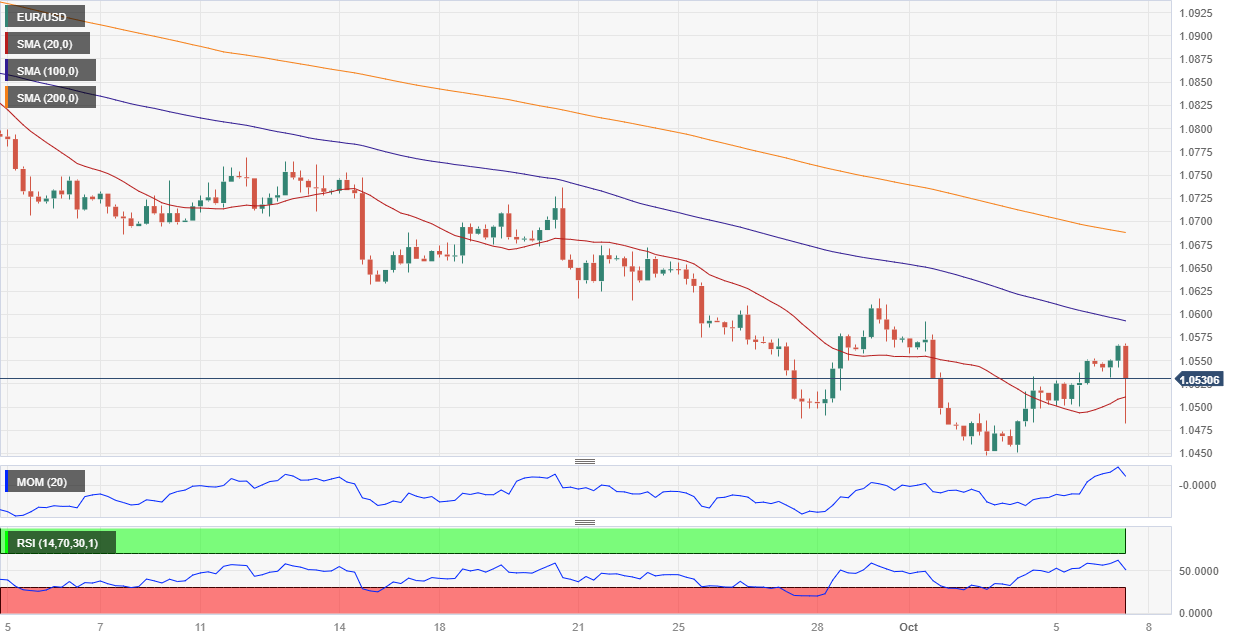- Euro Zone growth-related numbers indicated a steep economic contraction in Q3.
- The US Nonfarm Payroll report showed a strong American labor market.
- EUR/USD bearish continuation puts parity on the table before year-end.
The EUR/USD pair reached a fresh 2023 low of 1.0447, trimming part of its weekly losses ahead of the close to end the week at around 1.0520. The US Dollar retained its overall strength resulting from persistent concerns about the economic future, although extreme overbought conditions triggered a corrective decline mid-week.
In the end, what really matters is that government bond yields hit multi-year highs while stock markets posted substantial losses as continued inflationary pressures and a not-so-tight labor market leaves room for the Federal Reserve (Fed) to contract monetary condition further. As a result, the US Dollar finished the week with a firm tone across the board.
Throughout the first half of the week, investors paid attention to growth-related figures, which fell short of boosting the mood. S&P Global released the final versions of the September Producer Manager Indexes (PMIs), which confirmed the Euro Zone economy contracted sharply in the third quarter of the year, with modest revision in some of the indexes resulting from backlogs. On the other hand, the official United States (US) ISM Manufacturing PMI printed at 51.2 in September, while the services index printed at 50.1, both indicating expansion in the respective sector and reflecting US economic resilience.
Employment and inflation still in the eye of the storm
US employment-related figures released on Friday showed the sector remains tight, and that’s no good news for the Federal Reserve (Fed), which may need to keep rates higher for longer to tame inflation. According to the Nonfarm Payrolls report, the country added 336,000 new job positions in September, nearly doubling the market expectations. The Unemployment Rate remained steady at 3.8%, while the Labor Force Participation Rate was confirmed at 62.8%. The figures sent the 10-year Treasury yield to 4.887%, its highest since 2007, while the 2-year note offered as much as 5.15%, not far from the multi-year high posted at 5.20% mid-September.
Inflation will return to the spotlight next week, as Germany will publish the September Harmonized Index of Consumer Prices (HICP) while the US will unveil the Producer Price Index (PPI) for the same month. The US Federal Open Market Committee (FOMC) will publish the Minutes of the September meeting on Wednesday.
Finally, the US will unveil the September Consumer Price Index (CPI) on Thursday and the preliminary estimate of the October Michigan Consumer Sentiment Index on Friday.

EUR/USD technical outlook
The EUR/USD pair has been in a steady decline ever since reaching 1.1275 in mid-July, closing twelve consecutive weeks in the red. The pair is extremely oversold as corrective advances are shallow and short-lived, yet there are no technical signs of a mid-term interim bottom.
The weekly chart shows that the pair has extended its slide below a bearish 100 Simple Moving Average (SMA) for a fourth consecutive week, while the 20 SMA gains downward traction above it. Furthermore, technical indicators head firmly south within negative levels without indicating bearish exhaustion but instead supporting another leg south.
The EUR/USD outlook is bearish according to the daily chart. Technical indicators resumed their declines within negative levels after correcting extreme oversold conditions, reflecting sellers’ dominance. At the same time, a firmly bearish 20 SMA caps the upside at around 1.0610 while maintaining its downward slope well below the longer ones.
The aforementioned 20 DMA acts as an immediate resistance level ahead of the 1.0700 region, with a steeper correction expected on a break above the latter, aiming for the 1.0840/60 price zone. On the contrary, a break through 1.0447 would expose the 1.0320/40 region, followed by the 1.0260 price area.
EUR/USD sentiment poll
The FXStreet Forecast Poll shows bears are still leading the way, despite the increased risk of a bullish correction. The pair is seen on average, neutral in the near term but bullish in the monthly and quarterly views. The pair is seen at around 1.0800 in the three-month perspective, which will not be enough to confirm a trend change.
Finally, the Overview chart favors a downward continuation, as the three moving averages gained bearish traction, with strong downward slopes, and at fresh multi-month lows. Even further, lower lows are not in sight, with the pair seen as low as 1.0300 in the upcoming weeks. In the monthly view, most targets accumulate between 1.0400 and 1.0800, while the range barely increases in the quarterly view. On the contrary, a potential advance beyond 1.1000 seems less likely.

Information on these pages contains forward-looking statements that involve risks and uncertainties. Markets and instruments profiled on this page are for informational purposes only and should not in any way come across as a recommendation to buy or sell in these assets. You should do your own thorough research before making any investment decisions. FXStreet does not in any way guarantee that this information is free from mistakes, errors, or material misstatements. It also does not guarantee that this information is of a timely nature. Investing in Open Markets involves a great deal of risk, including the loss of all or a portion of your investment, as well as emotional distress. All risks, losses and costs associated with investing, including total loss of principal, are your responsibility. The views and opinions expressed in this article are those of the authors and do not necessarily reflect the official policy or position of FXStreet nor its advertisers. The author will not be held responsible for information that is found at the end of links posted on this page.
If not otherwise explicitly mentioned in the body of the article, at the time of writing, the author has no position in any stock mentioned in this article and no business relationship with any company mentioned. The author has not received compensation for writing this article, other than from FXStreet.
FXStreet and the author do not provide personalized recommendations. The author makes no representations as to the accuracy, completeness, or suitability of this information. FXStreet and the author will not be liable for any errors, omissions or any losses, injuries or damages arising from this information and its display or use. Errors and omissions excepted.
The author and FXStreet are not registered investment advisors and nothing in this article is intended to be investment advice.
Recommended Content
Editors’ Picks

US headline CPI came in at 2.4% YoY in March – LIVE
The latest figures from the Bureau of Labor Statistics (BLS) show that the headline Consumer Price Index (CPI) increased by 2.4% YoY last month—coming in below economists’ forecasts. Meanwhile, core CPI, which excludes the more unpredictable food and energy categories, climbed 2.8% over the last twelve months.

EUR/USD maintains its strong gains above 1.1100 post-US CPI
Heavy losses in the US Dollar prompt EUR/USD to flirt with the area of yearly peaks above the 1.1100 region following the release of US inflation readings in March.

Gold is trading on a positive footing near $3,130 after US inflation
Prices of Gold trade with marked gains following March’s US inflation prints, hovering around the $3,130 zone against the backdrop of a strong bearish bias in the Greenback and mixed US yields across the curve.

GBP/USD extends its advance to weekly highs on US CPI data
GBP/USD clinches its third consecutive daily advance, breaking above 1.2900 the figure and hitting fresh four-day highs in the wake of US inflation figures gauged by the CPI, and the weaker Greenback.

Trump’s tariff pause sparks rally – What comes next?
Markets staged a dramatic reversal Wednesday, led by a 12% surge in the Nasdaq and strong gains across major indices, following President Trump’s unexpected decision to pause tariff escalation for non-retaliating trade partners.

The Best brokers to trade EUR/USD
SPONSORED Discover the top brokers for trading EUR/USD in 2025. Our list features brokers with competitive spreads, fast execution, and powerful platforms. Whether you're a beginner or an expert, find the right partner to navigate the dynamic Forex market.
